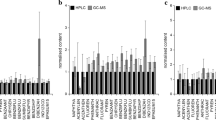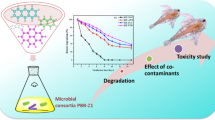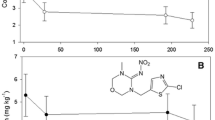Abstract
Goals, Scope and Background
Anaerobic digestion of organic household waste can lead to an increase in dioxin-like content, as determined by dioxin-specific bioassays. This may be a result of bioactivation of Ah receptor (AhR) agonists into more potent congeners. Work towards identifying the contributing compound groups is important in order to understand the mechanisms and to assess the relevance behind this increase in dioxin-like toxicity, since the residue can be used as a soil fertilising agent. The aim with the present work was to identify compound groups with AhR agonistic properties that caused the previously reported increase in dioxin-like activity after anaerobic biodegradation
Methods
Firstly, chemical fractionation combined with dioxin bioassay testing was used to find bioactive classes of compounds. Secondly, batch digestion experiments with an externally added polychlorinated biphenyl (PCB) mixture (Clophen A50) and with decabrominated diphenyl ether (decaBDE), respectively, were studied as a possible process for transformation of precursors into more potent, dioxin-like compounds. Mesophilic (37ºC) and thermophilic (55ºC) anaerobic digestion were studied. Two different dioxin-specific bioassays were used to analyse AhR agonists in the biodegraded material, the CELCAD and the DR-CALUX.
Results and Discussion
AhR agonist activity was detected in both di- and polyaromatic fractions of digestate extracts, which indicated that a diverse mixture of compounds contributed to the bioassay responses. No quantifiable activities were induced by the monoaromatic fractions. Further fractionation based on planarity revealed higher concentrations of AhR agonists than what was detected after the first fractionation, probably due to non-additive biological interactions of compounds in the extract that were removed in the second fractionation. These results showed significant activity in the non-planar diaromatic fractions and in the co-planar fractions of both diaromates and polyaromates. In the batch experiment with externally added PCB, an increase in dioxin-like activity was seen after 21 days of digestion at mesophilic conditions. After completed digestion, the content of AhR agonists was equal to the start concentration. PCB analysis with GC-MS indicated that dehalogenation of PCBs occurred in the digestors. The batch experiment with decaBDE showed no significant changes in TEQ-concentrations over time.
Conclusions
The results show that the previously reported increase of AhR agonists during mesophilic anaerobic digestion is probably due to an accumulation of several different groups of AhR agonists, both diaromatic and polyaromatic, and both co-planar and non-planar. Batch experiments with externally added PCBs and decaBDE, respectively, did not result in any accumulation of AhR agonist activity after completed digestion, even though chemical analysis indicate a dechlorination of PCBs. Complex, unfractionated extracts were difficult to test using the bioassay approach. Removal of AhR antagonists or otherwise interacting compounds during fractionation may yield bio-TEQ values that are much higher than in the original extract.
Recommendations and Perspective
Our results indicate that the environmental risk that AhR agonists may pose concerning large-scale anaerobic digestion of organic household waste probably depends on the efficiency of the digester and the sludge residence time. In order to obtain reliable results with the bioassays, an extensive cleanup and fractionation procedure is necessary. Without clean up and fractionation, there is a risk for false negatives and misleading conclusions. DR-CALUX and CELCAD were both suitable for these kinds of studies, provided that suitable fractionation methods are used.
Similar content being viewed by others
Author information
Authors and Affiliations
Corresponding author
Rights and permissions
About this article
Cite this article
Olsman, H., Schnürer, A., Björnfoth, H. et al. Fractionation and Determination of Ah Receptor (AhR) Agonists in Organic Waste After Anaerobic Biodegradation and in Batch Experiments with PCB and decaBDE (8 pp). Env Sci Poll Res Int 14 (Suppl 1), 36–43 (2007). https://doi.org/10.1065/espr2006.12.369
Received:
Accepted:
Published:
Issue Date:
DOI: https://doi.org/10.1065/espr2006.12.369




